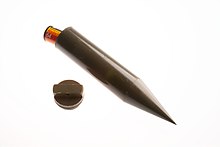Dead drop

A dead drop or dead letter box is a method of espionage tradecraft used to pass items or information between two individuals (e.g., a case officer and an agent, or two agents) via a secret location. By avoiding direct meetings, individuals can maintain operational security. This method stands in contrast to the live drop, which involves a face-to-face exchange.
Spies and their handlers have been known to perform dead drops using various techniques to hide items (such as money, secrets or instructions) and to signal that the drop has been made. Although the signal and location by necessity must be agreed upon in advance, the signal may or may not be located close to the dead drop itself. The operatives may not necessarily know or meet each other.[1][2]
Considerations
[edit]This section contains instructions, advice, or how-to content. (October 2024) |
The success of a dead drop depends on the location and method of concealment, ensuring retrieval without the operatives being spotted by the public, police, or other security forces. Common everyday items and behaviors are used to avoid suspicion. Any hidden location is used.

A dead drop spike is a concealment device similar to a microcache. It has been used since the late 1960s to hide money, maps, documents, microfilm, and other items. The spike is resistant to water and mildew and can be placed in the ground or submerged in a shallow stream for later retrieval.
Various signaling methods are employed to indicate that a dead drop has been made. These include chalk marks on a wall, a piece of chewing gum on a lamppostor a newspaper placed on a park bench. In some cases, signals are made from an agent's residence, visible from the outside, such as distinctively coloured towel hung from a balcony or a potted plant positioned on a windowsill.
Drawbacks
[edit]While the dead drop method is useful in preventing the instantaneous capture of either an operative/handler pair or an entire espionage network, it is not without disadvantages. If one of the operatives is compromised, they may reveal the location and signal for that specific dead drop. Counterintelligence can then use the dead drop as a double agent for a variety of purposes, such as to feed misinformation to the enemy or to identify other operatives using it or ultimately to booby trap it.[3] There is also the risk that a third party may find the deposited material.
Modern techniques
[edit]On January 23, 2006, the Russian FSB accused Britain of using wireless dead drops concealed inside hollowed-out rocks ("spy rock") to collect espionage information from agents in Russia. According to the Russian authorities, the agent delivering information would approach the rock and transmit data wirelessly into it from a hand-held device, and later, his British handlers would pick up the stored data by similar means.[4]
SecureDrop, initially called DeadDrop, is a software suite for teams that allows them to create a digital dead drop location to receive tips from whistleblowers through the Internet. The team members and whistleblowers never communicate directly and never know each other's identity, thereby allowing whistleblowers to dead-drop information despite the mass surveillance and privacy violations which had become commonplace in the beginning of the twenty-first century.
See also
[edit]References
[edit]- ^ Robert Wallace and H. Keith Melton, with Henry R. Schlesinger, Spycraft: The Secret History of the CIA's Spytechs, from Communism to al-Qaeda, New York, Dutton, 2008. ISBN 0-525-94980-1. Pp. 43-44, 63, and 74-76.
- ^ Jack Barth, International Spy Museum Handbook of Practical Spying, Washington DC, National Geographic, 2004. ISBN 978-0-7922-6795-9. Pp. 119-125.
- ^ Wettering, Frederick L. (2001-07-01). "The Internet and the Spy Business". International Journal of Intelligence and CounterIntelligence. 14 (3): 342–365. doi:10.1080/08850600152386846. ISSN 0885-0607. S2CID 153870872.
- ^ Nick Paton Walsh, The Guardian (23 January 2006). "Moscow names British 'spies' in NGO row". TheGuardian.com. Archived from the original on 29 August 2013. Retrieved 8 April 2012.
Bibliography
[edit]- "Russians accuse 4 Britons of spying".International Herald Tribune. January 24, 2006. News report on Russian discovery of British "wireless dead drop".
- "Old spying lives on in new ways". BBC. 23 January 2006.
- Madrid suspects tied to e-mail ruse. International Herald Tribune. April 28, 2006.
- Military secrets missing on Ministry of Defence computer files
- Robert Burnson, "Accused Chinese spy pleads guilty in U.S. 'dead-drop' sting", Bloomberg, 25 novembre 2019[1].
Further reading
[edit]- Robert Wallace and H. Keith Melton, with Henry R. Schlesinger, Spycraft: The Secret History of the CIA's Spytechs, from Communism to al-Qaeda, New York, Dutton, 2008. ISBN 0-525-94980-1.
